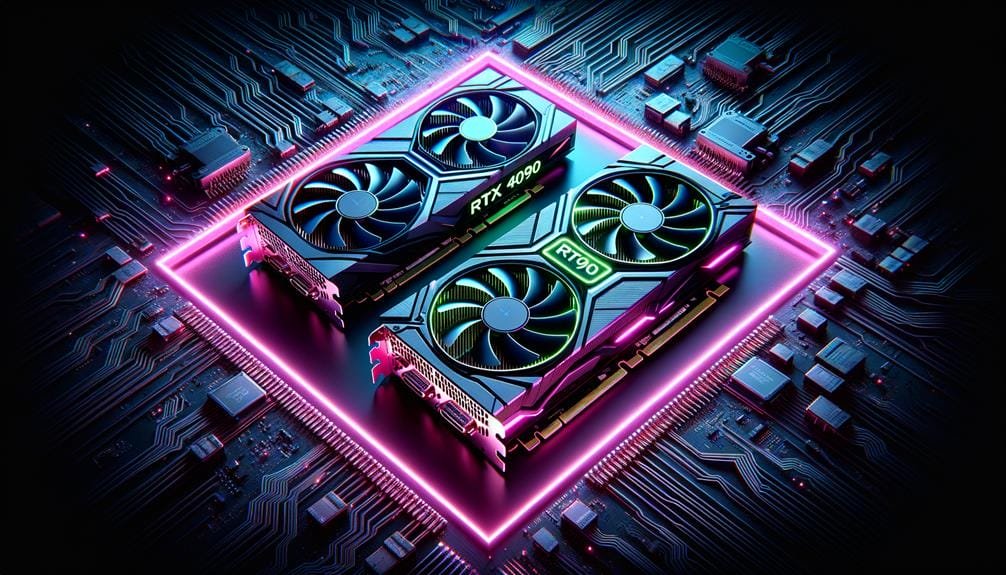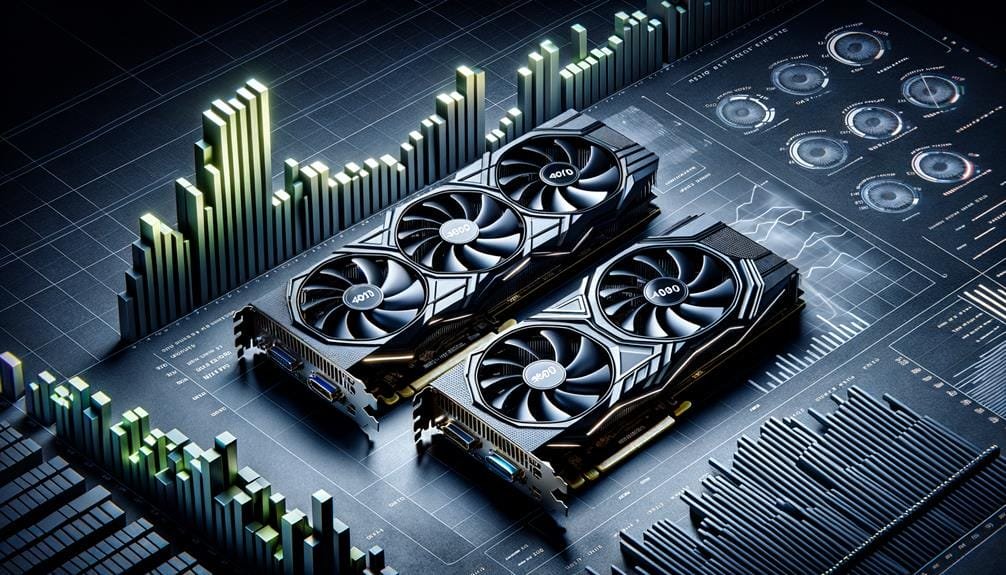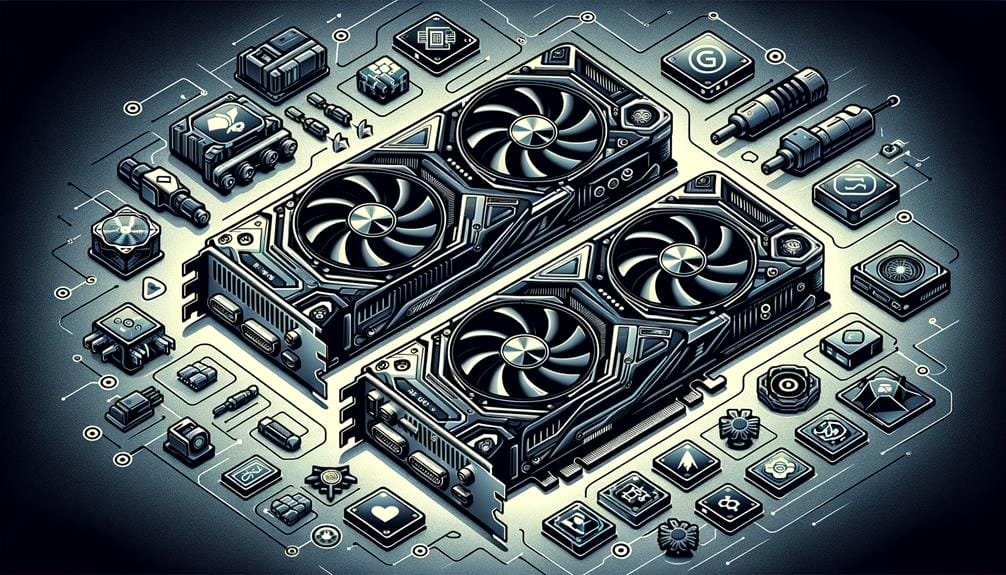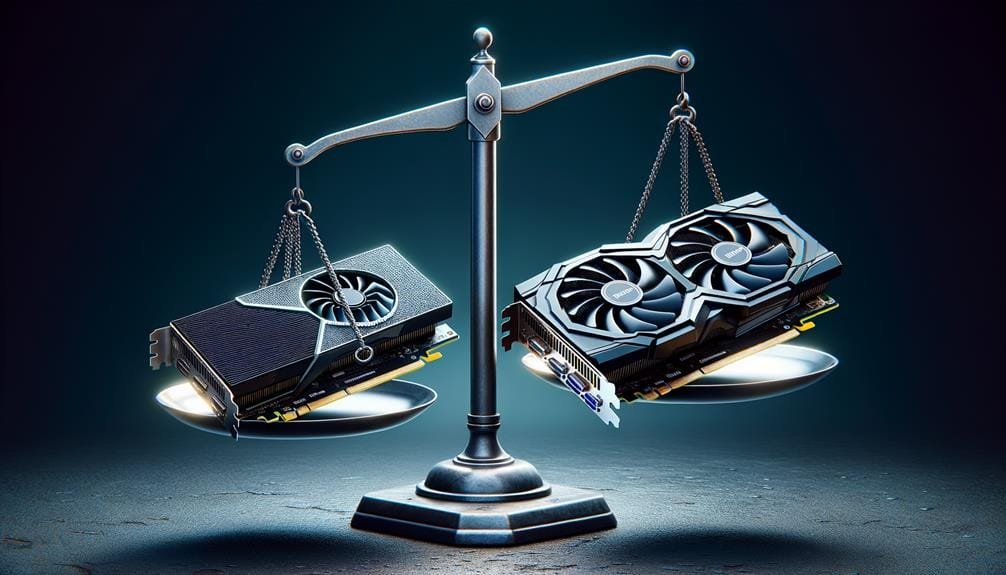Our Newsletter
Sign up for our e-mail newsletter and stay informed for what’s next on the horizon.
The Nvidia GeForce RTX 4090, a tour de force in Nvidia’s lineup And when considering upgrades, comparing the RTX 3090 Ti to the newer 4k GPUs like the RTX 4090 showcases substantial improvements in power and efficiencyComparisons between gen models highlight the continuous advancements in GPU technology. RTX 4080 are powerhouse GPUs. The 4090, with its 16,384 cores and 24GB GDDR6X memory, outperforms the 4080’s 9,728 cores and 16GB memory, excelling in complex tasks.
However, this comes with higher energy consumption and a need for robust cooling. The 4080, while less powerful, offers a balance of performance and efficiency. It’s also more budget-friendly. If you’re after the ultimate in gaming, especially 4K and ray tracing, the 4090 shines. But don’t discount the 4080 for solid, value-focused performance. Intrigued? There’s a suite of features still to explore. There’s even more to explore in the full comparison, including benchmark results.
As we kick off this showdown between Nvidia’s GeForce RTX 4090 and RTX 4080, we’re looking at an exciting landscape of advanced GPUs. Each offers unique innovations, and the purpose of our comparison is to highlight these while helping you decide which fits your needs.
Diving into the GeForce RTX 40-Series landscape, we find the RTX 4090 and RTX 4080 GPUs from Nvidia leading the pack with their massive advancements in performance and feature sets. These GPUs offer significant performance leaps, targeting high-end gaming And content creation, significantly enhanced by the technological advancements of the Ada Lovelace architecture and the efficiency of DLSS 3.
However, it’s not just about power; balancing performance gains, pricing, and hardware compatibility is key when choosing the GPU that best meets your needs, especially when considering whether to opt for the geforce RTX 4080 or comparing it to the RTX 4070 for a more budget-friendly option.
Let’s shift our focus to the key innovations that distinguish Nvidia’s GeForce RTX 4090 and RTX 4080, two GPUs that truly underscore Nvidia’s unwavering commitment to transforming gaming performance.
With more CUDA cores and their impact on achieving ultra settings in Game optimization now takes advantage of DLSS 3 for ultra settings.. and improved GDDR6X memory, they’re designed for intense gaming.
Advances in ray tracing and upgraded DLSS support further amplify these GPUs, showcasing Nvidia’s determination to push the boundaries of performance.
In our quest to determine the best GPU for your needs, we’re pitting the Nvidia GeForce RTX 4090 against the RTX 4080, analyzing their specifications, features, and gaming capabilities side by side.
We aim to help you understand the price-to-performance ratio, highlight each GPU’s strengths and weaknesses, and ultimately guide you in selecting the most suitable option for your gaming or content creation endeavors, especially if you’re going for 4K resolution.

Let’s start unpacking the key differences between the Nvidia Geforce RTX 4090, the flagship RTX model, a flagship 4k GPU, sets a new standard in performance. and RTX 4080.
We’ll look at everything from architectural innovations to the shift in VRAM and power consumption.
It’s all about understanding how these variations impact overall performance and efficiency, helping you make the best choice for your gaming and productivity needs.
Let’s begin our discussion on the architectural innovations in Ada Lovelace. Nvidia Geforce RTX 4090 and RTX 4080 GPUs.
We’ll start by delving into the role of CUDA cores in processing performance, and how RTX 4090’s impressive count of 16,384 CUDA cores compares to RTX 4080’s 9,728.
Then, we’re going to investigate the advanced features like ray tracing and tensor cores, and how they enhance the realism and AI capabilities in gaming and productivity tasks.
Often, we overlook the importance of CUDA cores in determining the performance of GPUs like the RTX 4090 and RTX 4080, but they’re vital for parallel computing tasks such as gaming and AI. The RTX 4090, when compared to the RTX 4070 Super, shows a significant difference due to this.
Understanding these cores helps us evaluate GPU capabilities.
Delving into the domain of ray tracing and tensor cores, we unveil the key architectural differences that differentiate the RTX 4090 from the RTX 4080, thereby enhancing realism in gameplay and other graphics-intensive tasks.
With more RT cores and GDDR6X memory, the 4090 delivers superior ray tracing and AI processing.
It’s the top choice for demanding tasks, thanks to its higher core count and memory capacity.
Let’s redirect our focus to the memory speed and bandwidth considerations of the RTX 4090 and RTX 4080.
As it’s evident, the RTX 4090 boasts a higher VRAM capacity, but what does that signify for you?
It’s time to delve into how these factors impact performance, and why they’re crucial in determining your preference between these two GPUs.
When examining the core distinctions between the Nvidia Geforce RTX 4090 and geforce RTX 4080, it’s important to look at their memory speed and bandwidth, particularly the VRAM capacities and how they utilize GDDR6X technology.
Let’s now turn our attention to power consumption, where the battle between efficiency and performance really heats up.
The RTX 4080 and 4090 have different power needs, an important factor in determining their usability in various systems.
We’ll be comparing their thermal design power, significantly improved from the RTX 4080 to the flagship RTX 4090and discussing how this ties into their overall performance and efficiency.
Diving into the thermal design and cooling solutions, the RTX 4090 and 4080 both sport efficient cooling systems, but their power consumption and the inclusion of Nvidia’s DLSS as a distinguisher challenge their efficiency heat management differ considerably due to their respective TDP is significantly higher, reaching 450w in models like the RTX 3090 Ti..
Both GPUs maintain ideal temperatures during intensive tasks.
Understanding these differences helps in choosing the right GPU.

Let’s gear up to examine the performance metrics of Nvidia Geforce RTX 4090 and RTX 4080.
We’ll inspect everything from benchmarking methodology and tools to the impact of technologies like Ray Tracing and DLSS on performance.
It’s all about determining which GPU offers the best bang for your buck, considering factors like frame rates and gaming benchmarks.
Let’s get down to the nitty-gritty: benchmarking these GPU titans.
We’re going to use tools like 3DMark, focusing on key metrics such as frames per second (FPS), power consumption, and temperature.
It’s all about finding that sweet balance between price, performance, and compatibility.
In our quest to unravel the performance mysteries of the Nvidia Geforce RTX 4090 and RTX 4080, synthetic benchmarks like 3DMark will play a pivotal role. They offer standardized testing methodologies for an objective evaluation of their graphical prowess. Here’s why:
While synthetic benchmarks give us a glimpse into the capabilities of the RTX 4090 and RTX 4080, it’s the real-world gaming performance that truly matters to users, and that’s where we’re diving in next. We’ve tested these GPUs on popular titles, using tools like MSI Afterburner and Fraps for accurate results. Here’s a brief rundown of our findings:
| Game Title | Resolution & Settings | RTX 4090 Performance (FPS) | RTX 4080 Performance (FPS) | Notes |
|---|---|---|---|---|
| Cyberpunk 2077 | 1080p, Ultra Settings + DLSS Quality | 140 | 110 | Utilizes DLSS for enhanced performance. |
| Call of Duty: Modern Warfare II | 1080p, Ultra Settings | 165 | 135 | High FPS for competitive advantage. |
| Assassin’s Creed Valhalla | 1080p, Ultra High Settings | 120 | 95 | Richly detailed open world. |
| Forza Horizon 5 | 1080p, Ultra Settings | 150 | 120 | Fast-paced racing with detailed environments. |
| The Witcher 3: Wild Hunt | 1080p, Ultra Settings + HD Reworked Project | 160 | 130 | Enhanced textures with the mod. |
The NVIDIA RTX 4090 demonstrates its prowess across all tested titles, delivering notably higher frames per second (FPS) than the RTX 4080. This is particularly evident in graphically intensive games like “Cyberpunk 2077” and “Assassin’s Creed Valhalla,” where the RTX 4090’s advanced architecture and larger memory buffer provide a significant performance boost.
In “Cyberpunk 2077,” utilizing DLSS (Deep Learning Super Sampling) allows both GPUs to achieve high FPS with improved image quality, though the RTX 4090 maintains a clear lead. Competitive titles like “Call of Duty: Modern Warfare II” benefit from the extra frames, offering smoother gameplay and a competitive edge on the RTX 4090.
Meanwhile, “The Witcher 3: Wild Hunt,” especially with the HD Reworked Project mod, showcases the RTX 4090’s ability to handle enhanced textures and complex lighting effects, delivering a more immersive gaming experience without sacrificing performance.
In our quest to find the superior GPU between the Nvidia Geforce RTX 4090 and RTX 4080, frame rates become our ultimate gaming benchmark.
It’s at different resolutions like 1080p, 1440p, and 4K that we can truly see the performance differences.
Delving deeply into the performance metrics, we find that the RTX 4090 outpaces the RTX 4080 by a considerable margin in frame rates across 1080p, 1440p, and 4K gaming, marking it as the ultimate gaming benchmark.
Let’s now turn our attention to what really sets these GPUs apart: ray tracing and DLSS.
As we examine the Nvidia Geforce RTX 4090 and RTX 4080, we’ll see how these features impact their performance.
We’re in for some intriguing insights into how they influence the gaming experience and the overall productivity tasks.
When we shift our focus to game titles that truly shine with ray tracing, it’s evident that games like Cyberpunk 2077 and Control exhibit immense visual enhancements when this feature is enabled.

Let’s start discussing the price tags of Nvidia Geforce RTX 4090 and RTX 4080, and what you’re getting for your money.
We’ll touch on the performance to cost ratio, shedding some light on which model might offer more bang for your buck.
Then, we’ll consider the long-term value of these GPUs, asking the essential question: is shelling out the extra cash for an upgrade truly worth it?
Let’s turn our attention to the pricing of the Nvidia Geforce RTX 4090 and RTX 4080.
We’re looking at a $400 difference, with the RTX 4090 being the pricier option.
However, the burning question is whether the increase in MSRP justifies the performance gain, and that’s what we’re here to analyze.
Nvidia’s launch of the GeForce RTX 4090 and RTX 4080, priced at $1,599 and $1,199 respectively, has stirred considerable interest among gamers and professionals alike, revealing a broad price spectrum for potential consumers to navigate.
We’ve observed:
Let’s kick off our discussion on the price-to-performance ratio between the Nvidia GeForce RTX 4090 and RTX 4080.
We’ll consider factors such as Cost per frame is substantially lower when you compare to the RTX 3090 Ti, especially in 4k gaming scenarios., balancing budget and performance, and how these two GPUs stack up against each other by comparing their specs and performance.
We’re breaking down these aspects to help you make the best possible decision for your gaming or productivity needs.
In our quest to understand the better investment between Nvidia Geforce RTX 4090 and RTX 4080, we need to explore the concept of calculating the cost per frame. This metric reveals the value and efficiency of a GPU through:
When we weigh the long-term value, the $400 price jump from the RTX 4080 to the RTX 4090 can indeed seem justified for those chasing excellent performance and future-proofing their systems.
The superior features and tech advancements offered by the RTX 4090 make it a compelling choice for enthusiasts and professionals.
Considering the performance gains and benefits, it’s a worthy upgrade.

Let’s talk about benchmark results and performance metrics at 1080p resolution Driver support has become increasingly important as desktop users transition between generations, such as from the RTX 3090 Ti to the newer RTX 4080 Super. and Game optimization has been significantly enhanced with the introduction of the RTX 4070 Super and RTX 4080 Super vs older generations..
How well a GPU performs is often closely tied to the quality of its drivers and the optimizations developers make for specific games.
We’ll also peek into the future of gaming, including VR and beyond, and see how these two GPUs stack up.
We’re about to discuss how Nvidia guarantees excellent gaming experiences with their RTX 4090 and RTX 4080 through driver support and game optimization.
It’s not just about the hardware; software compatibility plays a crucial role too.
To ensure peak performance across major gaming titles, Nvidia consistently releases driver updates for both RTX 4090 and RTX 4080, enhancing their capacities to the fullest. We’ve seen:
These efforts maximize the potential of both GPUs across various gaming genres and software platforms.
As we progress in the gaming world, it’s evident that VR is a significant part of that journey. Examining the Nvidia Geforce RTX 4090 and RTX 4080, we see how these GPUs are shaping the future of VR, providing unparalleled performance for immersive experiences.
Let’s delve into how these GPUs stack up regarding VR readiness and compatibility with demanding VR titles and software.
When it comes to VR readiness, the Nvidia Geforce RTX 4090 surpasses the RTX 4080, thanks to its superior 24GB VRAM that provides ample resources for an immersive VR experience.
Let’s kick off our chat about the market availability and consumer considerations regarding the Nvidia Geforce RTX 4090 and RTX 4080.
We’ll touch on where to find these GPUs, the current stock levels, a consideration when trying to find the RTX 4080, and what other buyers are saying about their experiences.
It’s about making sure we’re prepared for potential buying hurdles and ensuring we’re making the best choice for our gaming and productivity needs, comparing current models to the RTX 4070 Super for a comprehensive understanding.
When looking at stock levels and where to buy, it’s clear that the landscape for the Nvidia Geforce RTX 4090 and RTX 4080 is a bit challenging. We’re seeing demand outstrip supply, especially for the RTX 4090, making it a bit of a scalpers’ market.
As consumers, it’s key for us to keep an eye on various outlets and stay informed to snag these GPUs at reasonable prices.
Browsing through the scalpers’ market for the Nvidia RTX 4090 and RTX 4080 presents a significant challenge due to fluctuating stock levels and inflated resale prices.
We’ve heard from our engaged community of gamers and early adopters, and they’ve got plenty to say about their experiences with both the RTX 4090 and RTX 4080. From availability issues to the performance boost, their insights are pivotal in understanding the real-world implications of choosing one GPU over the other.
In the heart of online forums and social media platforms, we’re finding a wealth of consumer sentiment about the availability and pricing of Nvidia’s Geforce RTX 4090 and RTX 4080.

As we conclude this comparison, let’s sum up the battle between the RTX 4090 and RTX 4080.
Concerning future-proofing your gaming setup, it’s crucial to weigh the cost against the performance gains of each GPU.
Drawing the battle lines between the RTX 4090 and RTX 4080, it’s clear that each GPU caters to different consumer needs and budgets.
Both cards offer impressive capabilities, but your choice will ultimately depend on your specific needs and budget.
The RTX 4090, while costlier, delivers unparalleled gaming experiences.
When choosing between the RTX 4090 and RTX 4080, we must consider the longevity and future-proofing of our gaming setup. We’ve got to balance performance, pricing, and compatibility.
The RTX 4090, with its advanced capabilities and higher VRAM, certainly offers a more future-proof option. However, it’s essential to evaluate whether these advanced features are necessary for our setup within our budget.
In making the final call between the RTX 4090 and RTX 4080, we’ve got to weigh the balance between these GPUs’ performance, price, and compatibility.
Weigh these facts and make the choice that suits you best.
In wrapping up, the RTX 4090 does offer a 10% performance boost over the 4080, but it’s not a game-changer. Your choice really hinges on your specific needs and budget.
If you’re chasing ultimate performance, the 4090 might be your go-to. But, if value for money is your game, the 4080 stands strong. Remember, the best GPU for you is one that fits your purpose and pocket.
Happy gaming, and here’s to making informed choices!
When comparing Nvidia GeForce RTX 4090 and RTX 4080, the 4090 offers a significant performance boost over the 4080. The 4090 is built on the latest architecture and features enhanced ray tracing capabilities, DLSS 3 technology, and improved core counts.
Gamers looking for the ultimate performance and future-proofing may prefer the Nvidia GeForce RTX 4090 due to its higher specifications and power. However, the RTX 4080 still offers excellent gaming performance at a more affordable price point.
The price difference between the Nvidia GeForce RTX 4090 and RTX 4080 can be quite substantial, with the 4090 typically being priced higher due to its top-of-the-line specifications and performance.
Both the Nvidia GeForce RTX 4090 and RTX 4080 are capable of handling 4K gaming with ease. However, the 4090 may deliver smoother gameplay and higher frame rates in demanding 4K titles compared to the 4080.
Sign up for our e-mail newsletter and stay informed for what’s next on the horizon.